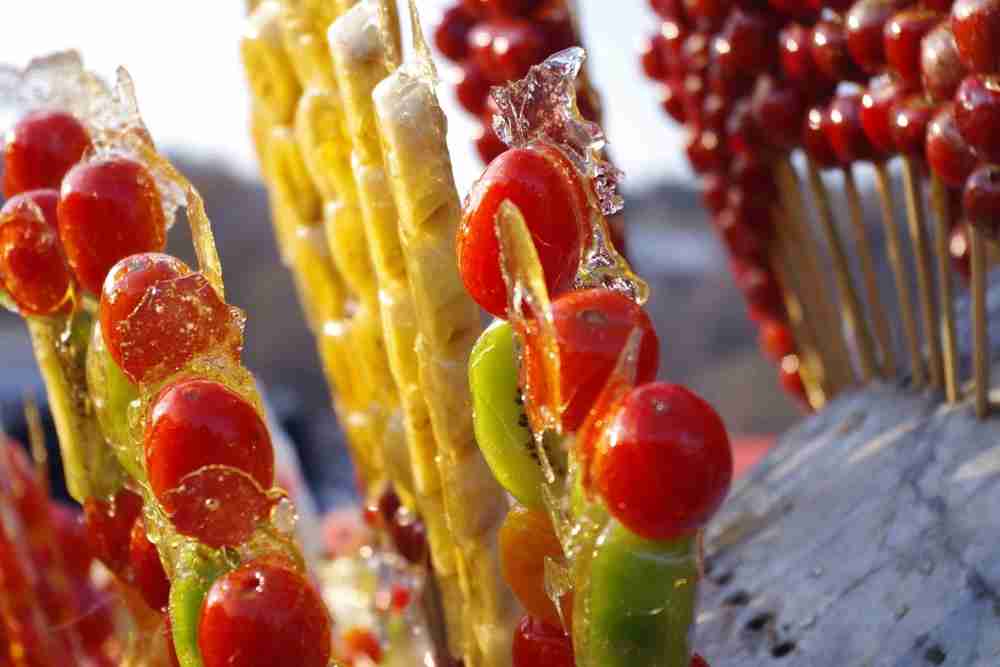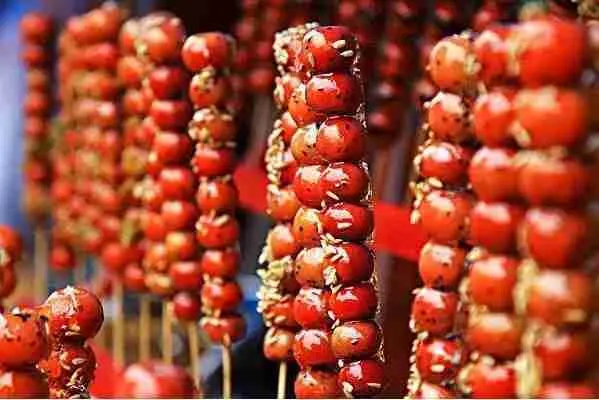If you’re planning to visit China, one of the most popular local snacks you are most likely to find in nearly all the places you end up visiting, is the Tanghulu. In this write-up, we will explore what Tanghulu is made of, its history, and how to make it at home.
What is Tanghulu Fruit/What is Tanghulu made of?

Tanghulu is a popular candied fruit snack that is found in most parts of Northern China. It is made from a candied mountain hawthorn, Chinese hawberry, Chinese haw, or Shanza fruit. While the hawthorn is the traditional fruit used to make the Tanghulu street snack, modern vendors tend to use other fruits such as mandarin oranges, kiwifruit, cherry tomatoes, blueberries, bananas, grapes, strawberries, and pineapples, among several others.
Tanghulu is completely different from the traditional candied fruit, which is often soft. The fruits are coated in a hardened sugar syrup that creates a hard crunchy, and tasty shell on the Tanghulu. The hardened fruits are then served in a long bamboo skewer, which is often about 20 centimeters long.
What does Tanghulu Mean?
Tanghulu, which is also known as Bingtanghulu, simply describes the candied fruit that is considered a street snack in most parts of Northern China. The common name ‘Tanghulu’ when translated literally means ‘sugar calabash’, and the name ‘Bingtanghulu’ when translated literally means ‘rock sugar calabash’. So, the rock sugar directly refers to the hard and crunchy sugar coating that is found on the snack, while the word ‘calabash’ refers to the slight resemblance of the snack to the general shape of a bottle gourd.
Tanghulu Origin/ Tanghulu History

According to Chinese historical records and other literary works, the Tanghulu fruit snack dates back to the Song Dynasty, which reigned between 960 and 1279. At one point in time, an imperial concubine of Emperor Guangzong, who reigned from 1147 to 1200, fell sick, and it was very challenging to find the right treatment for her. That got the emperor extremely worried, and he had to source for multiple doctors to help her out. One day, a doctor outside the court volunteered to cure the concubine’s sickness. After a quick examination, he prescribed haws simmered in sugar and water as the ultimate treatment for her illness. He requested that she eats 5-10 of them before each meal if she wanted to get better within two weeks.
The court physician and the Emperor did not believe anything the doctor said at the time. However, the concubine got better as the days went by. In the process, the story of the miraculous cure started to spread across the region. Vendors then started placing haws on long bamboo skewers then dipping them in hot sugar syrup before selling them as snacks. Supposedly, the first-ever tanghulu only had 2 haws: a big one towards the bottom and a small one at the top. It created the shape of a bottle gourd/Hulu when put together. Despite the fact that tanghulu today has about 4-8 haws and does not look like a candy bottle gourd, the name remains.
In the 1900s, tanghulu were popularly sold in food stores that were located in downtown Beijing, and they became even more popular than they were in the Song Dynasty. In addition to haws, most vendors often added ingredients such as Chinese dates, kumquats, water chestnuts, and yam, which balance the sweetness. However, the most attractive and popular varieties across China are the sugar-coated haws with crusty shells and fillings. Often, the haw is cut open, the seeds are removed, and then filled with sweet bean paste before being trimmed up using the softer parts of melon seeds. Currently, there are several Tanghulu makers all over China. Some have invested in trademarks for their brands and are even exporting a few pieces to neighboring countries.
How to make Tanghulu
Making Tanghulu has got to be the easiest thing that you may ever do. To get it right, ensure that the heat is completely under control at all times. Whenever the temperature of the syrup is too low, your tanghulu may end up very sticky. However, when the temperatures of the syrup are too high, then the candy coat over your tanghulu is bound to be very dark and have a bitter taste. To make the perfect Tanghulu, therefore, you can follow these steps;
- Start off by washing strawberries or any other fruit of your choice. Once done, dry the fruits and then arrange them on a bamboo skewer. If you are using long skewers, arrange about 4-6 fruits, but if you are working around a short skewer, consider 1-3 pieces of fruit per skewer.
- Once done, bring the water and sugar mixture to a boil. When doing this, use a candy thermometer to boil the sugar water mixture until the temperature reaches three hundred degrees Fahrenheit. Doing this should take you about 5 to 10 minutes. If you do not have a candy thermometer, however, you can choose to test the temperature of the water and sugar mixture by dipping a spoon in cold water and then into the syrup. Whenever the mixture hardens immediately, then it means that you have reached the appropriate temperature required for a well-done Tanghulu.
- At this point, you can dip your fruit skewers into your sugar mixture to easily coat the fruit. Once done, place each skewer over a parchment paper, a silicone baking sheet, or your sheet pan. Remember to spray pan spray over each surface to prevent sticking. Immediately after doing this, the coating should harden almost instantaneously, and you can feast on them right away. However, you can also store them in the refrigerator.
Conclusion
To date, Tanghulu remains a popular fruit snack in China. It is imply made by soaking a variety of fresh fruit pieces in a sugar and water syrup, then heating up the mixture until you are able to acquire a thick consistency that coats the fruits. All in all, the recipe above is idea for beginners and professional vendors alike.